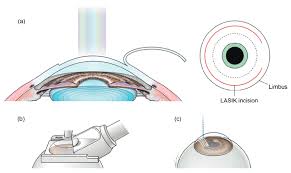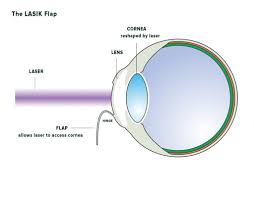Table of Contents
ToggleUndergoing LASIK surgery represents a significant and transformative decision for individuals who seek liberation from the reliance on glasses and contact lenses.
The procedure is renowned for its ability to correct vision problems and significantly reduce dependency on corrective eyewear.
However, like any surgical procedure, post-operative care is crucial to ensure optimal healing and outcomes.
A common question among LASIK patients is, “Can I use Visine after LASIK?” This blog aims to explore this question in detail, offering valuable insights into eye care post-surgery, the role of Visine, and alternative solutions for managing post-LASIK symptoms.
Understanding LASIK and Its After Effects
What is LASIK?
LASIK, or Laser-Assisted In Situ Keratomileusis, is a popular refractive surgery designed to correct vision issues such as myopia, hyperopia, and astigmatism.
The procedure involves reshaping the cornea using a laser, allowing light entering the eye to be properly focused onto the retina, thus improving vision.
While LASIK is generally safe and effective, it does come with temporary side effects that require careful management.
Common Post-LASIK Symptoms
After LASIK, patients may experience a range of temporary side effects as their eyes heal. These can include:
- Dry Eyes: A common side effect where the eyes produce fewer tears, leading to discomfort and itchiness.
- Blurry Vision: Temporary fluctuations in vision clarity as the cornea heals.
- Sensitivity to Light: Increased sensitivity to light sources, including sunlight and artificial lighting.
- Halos and Glare: Visual disturbances, especially noticeable at night or in low lighting.
- Redness and Irritation: Mild inflammation and redness as the eyes recover.
The Role of Eye Drops in Post-LASIK Care
To alleviate these symptoms and promote healing, eye drop medications play a vital role in post-LASIK care. They help keep the eyes moist, reduce inflammation, and prevent infection. Typically, surgeons prescribe a combination of antibiotic, anti-inflammatory, and lubricating eye drops for the initial recovery period.
Why Patients Consider Using Visine
Visine is an over-the-counter (OTC) brand of eye drops often used to relieve redness and minor irritations.
Many LASIK patients consider using Visine post-surgery to address lingering eye redness and discomfort. However, before reaching for this popular OTC solution, it’s essential to understand its mechanism and potential impact on post-LASIK recovery.
Can I Use Visine After LASIK?
The Science Behind Visine
Visine primarily offers relief through its active ingredient, tetrahydrozoline hydrochloride, which works as a vasoconstrictor.
Vasoconstrictors temporarily narrow the blood vessels in the eyes, reducing redness and swelling by limiting blood flow to the affected area.
While Visine can provide quick relief from redness, it doesn’t address the root cause of post-LASIK symptoms, such as dryness or inflammation.
Potential Risks of Using Visine Post-LASIK
Using Visine or similar vasoconstrictor-based eye drops after LASIK may pose several risks:
- Rebound Redness: Prolonged use of vasoconstrictor drops can lead to a condition known as rebound redness, where redness worsens when the drops are discontinued.
- Delayed Healing: Reducing blood flow may potentially interfere with the natural healing process of the corneal tissue after LASIK.
- Increased Dryness: Vasoconstrictors do not provide the lubrication needed for dry eyes and may exacerbate the dryness experienced post-LASIK.
- Interference with Prescribed Medications: Use of non-prescribed drops may interfere with the effectiveness of prescribed post-surgical medications.
Consult Your Ophthalmologist
Before using any OTC eye drops, it’s crucial to consult your ophthalmologist. They can provide personalised recommendations based on your specific condition and healing progress.
Many eye care professionals advise against using Visine post-LASIK, recommending lubricating or preservative-free artificial tears instead.
Alternatives to Visine for Post-LASIK Care
Artificial Tears
Artificial tears are the recommended approach for effectively managing dry eyes after LASIK surgery. These lubricating drops mimic natural tears, providing moisture and relief from irritation without the drawbacks of vasoconstrictors. Opt for preservative-free variants to avoid further irritation, especially with frequent use.
Prescribed Eye Drops
Follow your surgeon’s instructions regarding prescribed eye drops. These may include:
- Antibiotic Drops: To prevent infection during the initial healing phase.
- Anti-inflammatory Drops: To reduce inflammation and promote comfort.
- Lubricating Drops: To combat dryness and maintain eye hydration.
Warm Compresses
Applying warm compresses to your eyes can help soothe discomfort, promote tear production, and alleviate dryness. Utilise a clean, warm cloth and gently position it over your closed eyelids for several minutes.
Humidifiers
It is advisable to utilise a humidifier in your living environment to sustain optimal humidity levels. This can prevent excessive dryness in the environment, enhancing overall eye comfort.
Tips for Optimal Post-LASIK Recovery
- Adhere to Your Surgeon’s Instructions: Follow all post-operative guidelines provided by your surgeon, including the use of any prescribed drops.
- Avoid Rubbing Your Eyes: Rubbing can disturb the corneal flap and hinder healing. Protect your eyes from accidental rubbing during sleep by wearing the provided eye shields.
- Limit Screen Time: Reduce exposure to digital screens to prevent eye strain and dryness. Take regular breaks and adhere to the 20-20-20 rule: every 20 minutes, focus your gaze on an object 20 feet away for a duration of 20 seconds.
- Stay Hydrated: Drink plenty of water to support overall hydration, which benefits eye moisture.
- Wear Sunglasses: Protect your eyes from harsh sunlight and UV rays with sunglasses, especially during outdoor activities.
- Attend Follow-Up Appointments: Regular check-ups ensure your eyes are healing correctly. Report any unusual symptoms or concerns to your eye care professional immediately.
Next Steps
While Visine may seem like a convenient solution for post-LASIK redness, it’s essential to prioritise the specific needs of your healing eyes. Opting for appropriate lubricating solutions and following your surgeon’s guidance is paramount for a successful recovery. Always consult with your ophthalmologist before introducing new products into your post-surgical care routine.
For those seeking personalised advice and guidance, reaching out to eye care professionals is highly recommended. By taking a cautious and informed approach, you can ensure that your LASIK recovery is smooth and successful, ultimately leading to the clear and improved vision you seek.
If you have any questions or need further assistance, don’t hesitate to contact your LASIK provider or healthcare professional. Your eye health and comfort are of utmost importance as you transition into this exciting new chapter of vision clarity.













